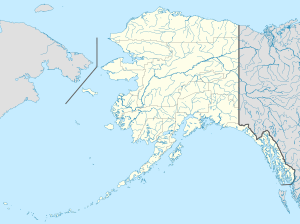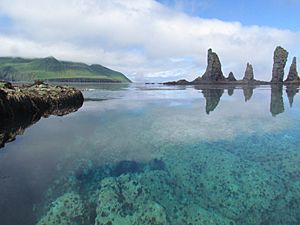Alaska Maritime National Wildlife Refuge facts for kids
Quick facts for kids Alaska Maritime National Wildlife Refuge |
|
|---|---|
|
IUCN Category IV (Habitat/Species Management Area)
|
|

Alaska Maritime National Wildlife Refuge, Aleutian Island Unit
|
|
| Location | Alaska, United States |
| Area | 4,900,000 acres (20,000 km2) |
| Established | 1980 |
| Governing body | U.S. Fish and Wildlife Service |
| Website | Alaska Maritime NWR |
The Alaska Maritime National Wildlife Refuge (often called Alaska Maritime or AMNWR) is a huge protected area in Alaska, United States. It's like a giant nature park made up of about 2,400 islands, rocky cliffs, and small land pieces. This amazing refuge covers a massive area. It stretches from Cape Lisburne in the north to the very tip of the Aleutian Islands in the west. It also reaches down to Forrester Island in the southern Alaska Panhandle.
This refuge has many different types of land. You can find tundra (flat, treeless plains), rainforests, steep cliffs, volcanoes, sandy beaches, lakes, and streams. It's a truly wild and varied place!
Contents
Amazing Animals of the Refuge
The Alaska Maritime National Wildlife Refuge is super famous for its huge number of seabirds. About 75 percent of all native Alaskan marine birds live here. That's between 15 to 30 million birds from 55 different species!
Seabird Cities
AMNWR is also a nesting spot for an estimated 40 million seabirds. This means about 80 percent of all seabirds in North America use this refuge to lay their eggs and raise their young. These birds gather in huge groups called "bird cities" or colonies along the coast. Each type of bird has its own special place to nest. Some like rock ledges, others prefer small cracks, piles of rocks, tall spires, or even burrows in the ground.
Other Wildlife
But it's not just birds! Many other cool animals live in this refuge. You might spot caribou, sea lions, bears, coyotes, seals, and Canadian lynxes. There are also beavers, foxes, muskrats, wolf packs, and moose. In the waters, you can find walrus, river otters, whales, and sea otters. High up in the mountains, you might even see Dall sheep.
About the Refuge Headquarters
The main office and visitor center for the Alaska Maritime National Wildlife Refuge are located in Homer, Alaska. This is where you can learn more about the refuge and its amazing wildlife.
In 1968, a part of the refuge called Simeonof National Wildlife Refuge was named a National Natural Landmark. This means it's a very special natural place recognized by the National Park Service.
How the Refuge is Organized
The Alaska Maritime National Wildlife Refuge is so big that it's divided into five main sections, or "units." These units are spread out all around Alaska.
Gulf of Alaska Unit
This unit is in the southeastern part of Alaska. It includes several important islands and island groups:
- Saint Lazaria Wilderness (Saint Lazaria Island)
- Hazy Islands Wilderness (Hazy Islands)
- Forrester Island Wilderness (Forrester Island, Lowrie Island, Wolf Rock)
- Barren Islands (like East Amatuli Island and West Amatuli Island)
- Tuxedni Wilderness (Chisik Island, Duck Island, and Egg Island)
- Middleton Island
- Chiswell Islands
- Trinity Island (Sitkinak Island)
Alaska Peninsula Unit
This unit is located along the Alaska Peninsula. It contains:
- Sutwik Island
- Semidi Wilderness (Semidi Islands: Aghik Island and Chowiet Island)
- Simeonof Wilderness (Simeonof Island, which is part of the Shumagin Islands)
Aleutian Islands Unit
This unit covers most of the land in the long chain of the Aleutian Islands. It stretches from Unimak in the east all the way to Attu in the west. Key areas include:
- Unimak Wilderness (Unimak Island)
- Aleutian Islands Wilderness
- Bogoslof Wilderness (Bogoslof Island)
Bering Sea Unit

This unit is located in the Bering Sea. It has several important islands:
- Hagemeister Island
- Pribilof Islands (St. George Island, St. Paul Island, Otter Island, Walrus Island)
- Bering Sea Wilderness (St. Matthew Island, Hall Island, Pinnacle Island)
- Besboro Island
- Sledge Island
- King Island
Chukchi Sea Unit
This unit is in the Chukchi Sea, in the northern part of Alaska. It includes:
Images for kids
-
Gull Island, a small rocky outcropping on Kachemak Bay is the summer home to an estimated 10,000 seabirds
-
Thick-billed murres in the refuge
-
East Amatuli Island, Barren Islands, Gulf of Alaska Unit
-
Three walrus near Cape Lisburne










